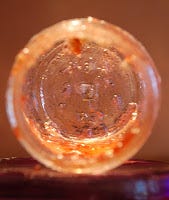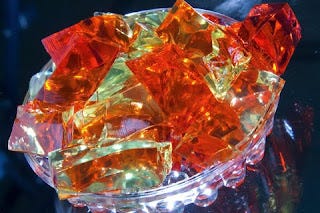The Glycocalyx, Our Jelly Filling
The glycocalyx is a free form matrix made up of a jelly like mixture of starches, fluid, ions and other goo. Gelatin desserts are well known examples of a free form matrix supported by the starch, pectin. The glycocalyx jelly layer may act like glue between cells or like sealant coating the interior and exterior of pipes in plumbing repair. It protects our surfaces around cells and the lining of blood vessels and organs. The stickiness allows cellular interactions to take place more easily between white blood cells and protein receptors found in cell membranes. Imagine trying to build a garden hose out of lettuce leaves and strawberry jam - that is kind of how a blood vessel is made.

A gelatin dessert is
The faster current in blood vessels can flow on while white blood cells can pause and perform tasks safely sticking in the slower goo of the glycocalyx layer. It reminds me of the muddy bottom of river beds where minnows hide and frogs lay eggs. The glycolipids and glycoproteins may be long and branching like sea-weed and algae and the fibrous mixture may be like a net, slowing down and trapping things flowing by in the blood stream or in other vessels like airways and the digestive track. (Strolling through the skin, a live action video of the fibrous collagen network that supports our skin and other ligaments, blood vessels and organs, youtube.)

The inside of a jelly jar.
Our intestines are miles long and wide open to every passing food particle unless our cells are replaced regularly and are well coated with the glycocalyx layer. The digestive track has the shortest lived cells in the body. They are replaced every seven days on average – that is a lot of miles of cells for our white blood cells to patrol in order to identify the decaying ones and provide them a quick death by apoptosis.
Apoptosis is nature’s control over pre-cancerous, decaying cells. Well nourished white blood cells can recognize the old or infected cells, give them a little enzyme blast of death and then engulf the waste material, resulting in no inflammation or discomfort to us. It happens every day. Apoptosis requires the white blood cell to have nutrient building blocks for all the chemical steps in the process, and the white blood cell membrane has to join with the other cell membrane temporarily probably occurring within the glycocalyx layer.
The intestines also need plenty of fiber from our diets to build and rebuild the jelly layer coating its surfaces. Animal foods do not offer any fiber for building this protective layer and a diet high in meat and dairy and refined grains can leave the body more open to allergens and infection. Fiber is found in all plant foods and whole grains. A fiber pill or fortified food is unlikely to meet our need for a variety of different starches. Vine ripened produce has a higher content of some of the essential types of starches then produce that is picked early and forced to ripen with plant hormones. Frozen and canned vegetables are picked at peak ripeness and then processed rapidly. They lose some nutrients in processing but will retain value over time. Fresh produce will retain nutrient value longer when stored as recommended for the variety.
Some natural food sources of healthy types of fiber include: Carrots, apples, pears, pre-ripened peaches and nectarines, berries, cherries, sweet potatoes, onions, garlic, peas, green beans, other beans, nuts, seeds, guava, turnips, mushrooms, corn, leeks, dark greens, fenugreek, aloe vera, slippery elm powder, marshmallow root, cinnamon, turmeric, horseradish and ginger. And other whole fruits, vegetables, herbs, and spices would also be sources of fiber. It is found in all plant foods.
Glucosamine is one of the super starches. It is important within bone tissue and may help those with arthritis problems. A typical supplement size is a large 1500 mg capsule once a day or three 500 mg tablets. Supplemental glucosamine is usually extracted from shells of crustaceans and can be a risk if there is an allergy to seafood. Glucosamine derived from corn has been developed and hopefully will make it into a variety of foods soon. Glucosamine derived from corn is available as a vegan source of the supplement at Deva Nutrition: [devanutrition.com].
/Disclosure: This information is provided for educational purposes within the guidelines of fair use. While I am a Registered Dietitian this information is not intended to provide individual health guidance. Please see a health professional for individual health care purposes./
85. [dvd.sagepub.com] Noble, M., Drake-Hollan, A., Hyperglycaemia and the vascular glycocalyx: the key to microalbuminaria and cardiovascular disease in diabetes mellitus? (British Journal of Diabetes & Vascular Disease 2010 10: 66) DOI: 10.1177/1474651409357035
86. [jasn.asnjournals] Singh, A., Satchell, S. C., Neal, C. R., McKenzie E A., Tooke, J E., and Mathieson P. W., Glomerular Endothelial Glycocalyx constitutes a Barrier to Protein Permeability, (J Am Soc Nephrol 18: 2885-2893, 2007.) DOI: 10.1681/ASN.2007010119) Full text
87. [nutritionj.com] Ramberg, J. E., Nelson, E. D., Sinnott, R. A., Immunomodulatory dietary polysaccharides: a systematic review of the literature, (Nutrition Journal 2010, 9:54) DOI:10.1186/1475-2891-9-54
89. [ncbi.nlm.nih.] Reitsma, S.,,et al The Endothelial glycocalyx: composition, functions, and visualization, (Pflugers Arch – Eur J Physiol (2007) 454:345-359) DOI 10.1007/s00424-007-0212-8
90. [ircres.ahajournals] Barakat, A. I., Dragging Along; the Glycocalyx and Vascular Endothelial Cell Mechanotransduction, (Circulation Research. 2008;102:747.748) 2008 American Heart Assoc.
Addition - more recent research has been examining how intracellular structures tend to stay semi-fluid or aggregate into separate droplets like water and oil will separate into layers in some types of salad dressings. Several chronic illnesses and neurodegenerative disorders seem to involve protein clumping and intracellular fluid changes. https://www.nature.com/articles/d41586-018-03070-2?utm_source=twt_nnc&utm_medium=social&utm_campaign=naturenews&sf204568751=1
Magnesium and calcium both are involved in stabilizing or disrupting membrane structure in cell walls or cellular structures. Increasing concentrations of either cause the clumping/disrupting effects but the effect occurs at lower concentrations of calcium then magnesium. https://www.biorxiv.org/content/biorxiv/early/2018/10/24/453019.full.pdf
During normal health more calcium is available in extracellular fluid and more magnesium is in the intracellular fluid. Both are kept within very narrow ranges. Back stock, extra supplies, are carried in a non-electrically active way on protein or phospholipid transport molecules. When less protein or phospholipid is available then less magnesium is available within the cell in the inactive form which is normally released if needed in case of traumatic injury or other issues cause a need for more of the electrically active mineral. It is used to control flow of other minerals and molecules across cell membranes. See Magnesium in the Central Nervous System for more information. https://www.adelaide.edu.au/press/titles/magnesium/
Summary points based on the textbook regarding magnesium sources, symptoms of deficiencies and food sources of phosphonutrients: https://transcendingsquare.com/2018/07/20/to-have-optimal-magnesium-needs-protein-and-phospholipids-too/
More about magnesium and phospholipid bilayers https://www.ncbi.nlm.nih.gov/pmc/articles/PMC2754194/
Ionic plasma/electrical fields are being experimentally tested to help wound healing in diabetics. Activation of Nrf2 pathways and rebalancing oxidative stress chemicals seems to be involved. The treatment also helps stabilize the cellular matrix/ the glycocalx layer of the healing wound.
Redox for Repair: Cold Physical Plasmas and Nrf2 Signaling Promoting Wound Healing https://www.mdpi.com/2076-3921/7/10/146/htm



